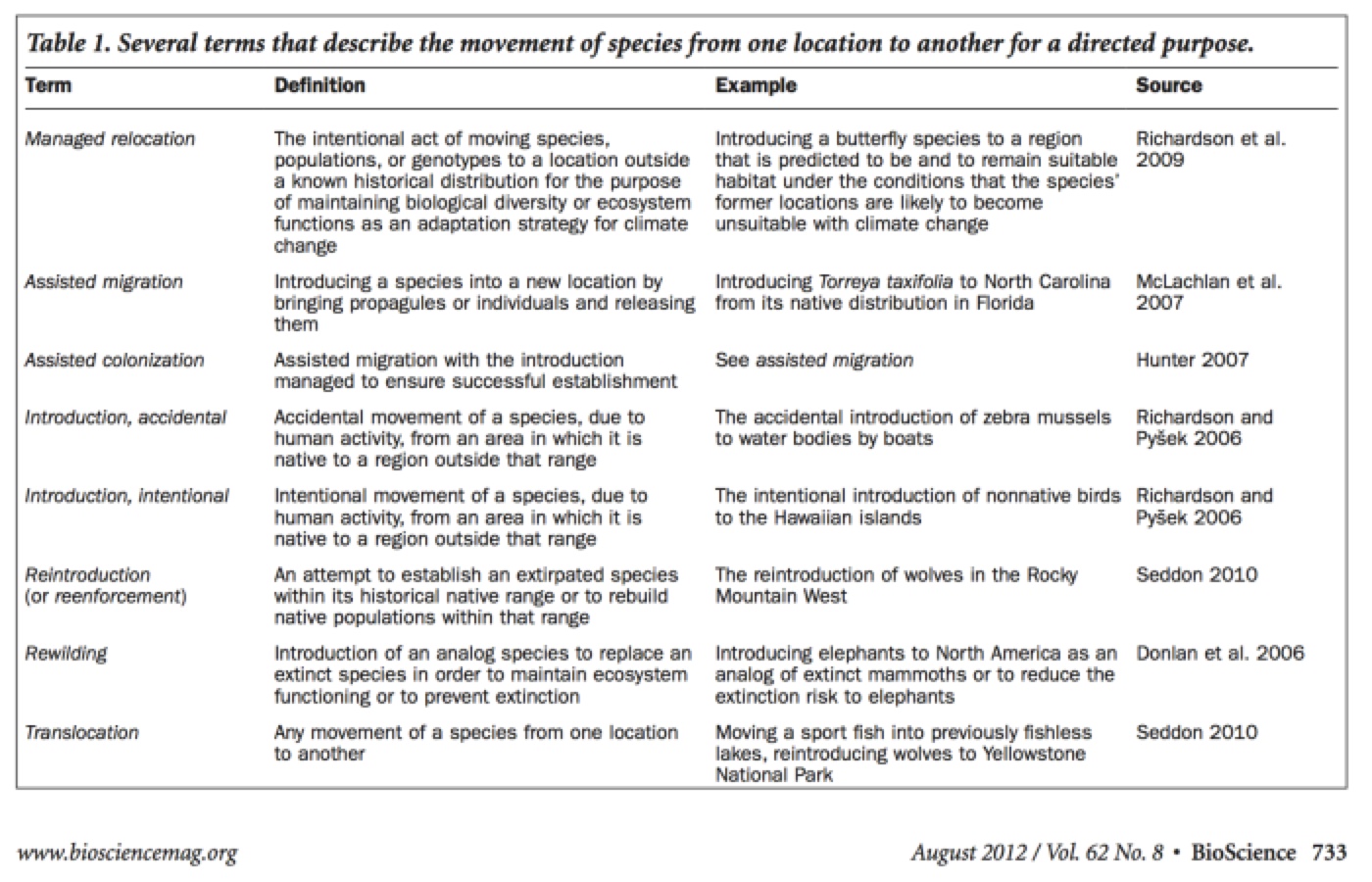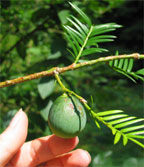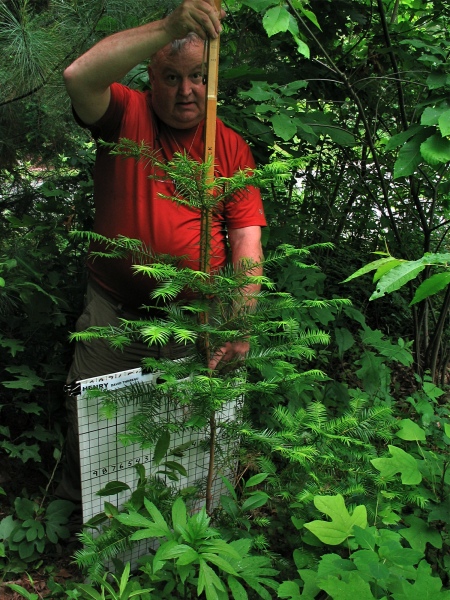|
Re "Managed Relocation:
COMMENTS by Connie Barlow, Torreya Guardian
Taking just those two terms, one might wonder why anyone would bother to deliberately engage in assisted migration, rather than assisted colonization. Notably, some of the projects being undertaken by Torreya Guardians are indeed "assisted migration" (followed by ongoing monitoring) — without our taking additional steps "to ensure successful establishment." While it is true that several northward growers in our group are continuing to water, sunshade, and otherwise beneficially intervene with nurturing their young plants from year to year, their efforts will primarily yield the earliest seed production from this "migrated" species; their plantings are thus more in the frame of an orchard, which in itself will be very useful as a seed generator. In contrast, two of our project sites (Waynesville and Junaluska NC) introduced specimens into semi-wild deciduous-canopy forested habitats, in which a hands-off approach (after initial post-planting watering) is the management norm. The reason? Our aim is to discover which elevations, aspects, slopes, hydrology, associated species, etc. are Torreya's preferred habitat conditions.Thus, when our May 2012 monitoring of these two sites began to yield important data indicative of distinct habitat preferences (and habitat stressors), we did not intervene to "help" the struggling or dying specimens. Indeed, we were excited to discover that an oak-hickory canopy with associated dry-adapted species (sassafras and flame azalea) are very stressful, even lethal, to Torreya taxifolia. In contrast, moist deciduous indicator species were the plants associated with specimens that were doing the best. Please access our monitoring report: "What We Are Learning About Torreya's Habitat Preferences". A second reason why the 2012 paper's definition of "assisted migration" does not accurately depict the intentions of what we at Torreya Guardians are doing is that, with respect to our particular species, the core group of activists and private landowners believe that our actions are simply assisting this species in mirroring the natural northward migrations it is reasonably assumed to have undertaken in sync with the onset and intensification of previous interglacial episodes of climate warming during the Pleistocene. T. taxifolia's "historic native range" is, after all, also known to be a well-established "pocket glacial refugium," and thus it served as a vitally important refuge for eastern deciduous forest species at the peak of each glacial episode. That is why the late Paul S. Martin (Pleistocene ecologist) depicted Torreya taxifolia as having been "left behind in near time." See our 2004 paper on this topic, "Bring Torreya Taxifolia North — Now". What the word "migration" thus means in this context is not the annual migration of seasonally resident animal species but the epochal movements of the species at the timescale of Milankovitch cycles. By using the term "migration" to depict what we are are assisting Torreya in doing, rather than "colonization" or "relocation," we hope that regional residents near our project sites will be able to grasp that we are simply assisting this endangered species in doing what it naturally has done in previous warming periods. The term "assisted migration" thus has a far less interventionist aura to it than does the hegemonic feel of "colonization" or "relocation." This leads to a second aspect of the 31-author paper that I am very pleased to see.
The above-titled section of the Managed Relocation Working Group (MRWG) 2012 BioScience paper begins: In my view, until conservation biologists and managers and the public at large are given an opportunity to reflect on how long-lived species and genera of plants (such as Torreya) have indeed had to migrate long distances in the past, this issue of "managed relocation" will continue to foment more discord than necessary. We must cast what we are doing (or thinking about doing) not in the light of purely artificial intrusions in natural ecological dynamics but rather as necessary assistance in helping plants do what they have naturally done over the course of millennia and millions of years.
Indeed, I would not have initiated the Torreya Guardians movement simply on the basis of experiencing the species as doomed and feeling sorry for it; a deep-time paleoecological perspective (which I gained largely thanks to Paul S. Martin and Hazel Delcourt) was the crucial impetus moving me into action. My sense was that the managers and ecologists in charge of the Endangered Species Act (ESA) management of Torreya taxifolia lacked this perspective, and thus would continue to constrict their management focus exclusively to the ever-degrading "historic range" in Florida. Sadly, this proved to be true: In June 2010 Torreya Guardians were the only participants to vote "Yes," when the USF&WS staffer in charge of the ESA management plan update for T. taxifolia asked the gathered advisors whether a "pilot project" to test planting Torreya taxifolia to the north of its historic range should be added to the management plan. (You can access ours and other comments via: http://www.torreyaguardians.org/esa-recovery-plan.html.)
Frustrated by the lack of a deep-time perspective by the ESA advisory group for Torreya, I wrote and posted online the essay that I am grateful the Bioscience paper chose to include in its References Cited: "Paleoecology and the assisted migration debate: Why a deep-time perspective is vital".
Page 739 of the BioScience paper includes this: "For example, compared with ruderal species, slow growing, shade-tolerant, long-lived trees are probably more likely to require managed relocation, and they are also often less likely to become widespread invaders. In general, introduced plants are less likely to cause rapid extinctions than are introduced animals, because predation is the principal interaction that leads to rapid extinction (Sax and Gaines 2008). Relocations within continents that do not transgress major biogeographical boundaries (e.g., mountain ranges) could reduce the risk of unforeseen negative consequences (Mueller and Hellmann 2008)." Mueller and Hellman's work on invasion risk is, in my view, one of the most important contributions in the debate, yet the Torreya ESA management plan advisors in 2010 seemed utterly unaware of it when they were voicing their "No" votes on whether to include a pilot project for planting T. taxifolia to the north. That is why my written comments on the management plan update included this paragraph:
4. RECOMMENDATION FOR FURTHER WORK by the Managed Relocation Working Group
While it is understandable that many environmental activists working to reduce the global carbon footprint would still be hesitant to acquiesce to any "adaptation" strategy regarding biodiversity preservation, and why the public educated about the dangers of "invasive species" would naturally be wary of the de facto pilot project being undertaken openly and with as much scientific rigor as we Torreya Guardians can muster (as volunteers with no financial assistance), it seems that the 31 coauthors of the BioScience paper could easily take additional steps to bring some commonsense understandings to the debate.
Perhaps the most important additional task the group could easily take on would be to construct a table of nuanced definitions for what is meant by "native habitat" or "historic habitat."
Paul Martin's and my 2004 paper included an appendix, where we offered proposed "Standards for Assisted Migration of Plants". At the bottom of that short list, we offered some short definitions, which would be a place for the MRWG to begin their own assessment:
A table of such definitions would be helpful because I sense that an unnecessary polarity within the working group has developed — between those who want to retain a historic "baseline" approach for biodiversity and ESA management and others who would toss out the idea of baseline altogether, and simply assess where in the future species would need to move in order to stay in sync with the movement of its habitat conditions. (See, for example, in 2011 Hellmann and Pfrender concluded, ". . . we can no longer look to the past for guidance on how an ecosystem is supposed to be.")
I agree with Hellmann and Pfrender as to the historic past — but the near-time and deep-time pasts can still be very helpful. Overall, there is no need to throw out the idea of a baseline. We just need to introduce some nuances into what baselines might be consulted (hence my strong recommendation for the MRWG to tackle temporally nuanced definitions of native habitat).
I suggest that the group construct definitions for at least this set of terms: Current range, Historic range, Near-Time ranges (including Pleistocene Glacial Peak, Pleistocene Interglacial Maximum, and Pleistocene Migration Path ranges), and various Deep-Time ranges. Indeed, I was grateful to see that on p. 738 of the BioScience paper, the map is labelled as showing the "Post-Pleistocene Historic Range" of T. taxifolia — so you already are beginning to make such distinctions. Formalizing those distinctions as definitions that can then enter common use in the debate would be a big contribution.
Note: I believe that Paul S. Martin was one of the key originators of the phrase "deep time" and that paleontologist Ross McPhee at the American Museum of Natural History originated the phrase "near time." McPhee is the editor of a conference volume in the late 1990s, Extinctions in Near Time. (Paul Martin spoke at that conference.) If any of you want to learn more about the deep-time work of Paul S. Martin, visit this page I created for access to some of his online available work: http://thegreatstory.org/paul-martin.html.)
PHOTO LEFT: Lee Barnes, May 2012, measuring the height of a young Torreya tree planted (as a foot-high seedling) at Corneille Bryan Native Garden during an "assisted migration" effort undertaken by Torreya Guardians in July 2008.
END OF COMMENTS BY CONNIE BARLOW
— Hazel Delcourt
Return to HOME PAGE.
Annotated List of Papers/Reports Online re Assisted Migration
|



